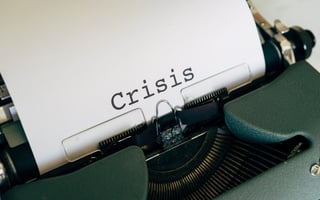On our crisis communication training courses, we often look at examples of how others managed their...
We are often asked during our crisis communication training courses whether organisations should try to put an incident into context.
This is a particularly tricky area of crisis media management.
While the temptation is easy to understand, particularly when an organisation feels it has been placed in the spotlight unfairly, there is plenty of scope for things to go badly wrong.
Let’s start by looking at an example of how trying to add ‘context’ can increase reputational damage.
Out of proportion?
An example that sticks in my mind when we discuss this issue comes from Oxfam.
In 2018, its then chief executive, Mark Goldring gave an interview to the Guardian where he complained about the coverage the charity had received over its sex abuse scandal.
He claimed the criticism it had received had been ‘out of proportion’ and suggested the charity was being treated as if it had ‘murdered babies’.
He said: “The intensity and the ferocity of the attack makes you wonder, what did we do?
“We murdered babies in their cots? Certainly, the scale and the intensity of the attacks feels out of proportion to the level of culpability.
“I struggle to understand it. You think: ‘My God, there’s something going on there.’”
Three years on, and it is still baffling that he took this approach and used these words.
It serves as a great reminder of the risks of trying to put a crisis into context. But sometimes attempting to add context is not as glaring as this. More common variations include ‘this is an isolated incident’, ‘a minor incident’ or ‘only a small number of people have been affected’.
No excuses
We’ve probably all used these sorts of phrases at some point as we try to pack some reassurance into crisis responses. But trying to put a crisis incident in context like this can all too easily seem like an attempt to excuse what has happed.
It runs the risk of people – your customers (or supporters in the case of Oxfam) - believing you are trying to downplay what has happened, to justify it or to deflect the blame on to someone else.
The best response is to issue a timely apology that sounds sincere and expresses regret.
But this doesn’t mean context cannot ever be used in crisis media management.
It was something the late Steve Jobs certainly tried to do when Apple was in the spotlight.
For example, when issues with the iPhone 4's wraparound antenna design were making headlines, he called a press conference where he essentially suggested the problem was blown out of proportion.
He said: “The heart of the problem is that smartphones have weak spots. We made it very visible.
"This is life in smartphone world. Phones aren't perfect. Almost every smartphone we tested behaved like this.
"There is a problem, but that problem is affecting a small percentage of users."
He also went on to criticise the media coverage, saying: “I guess it's just human nature that if someone or some organisation gets really successful, there's just a group of people who want to tear it down. I see it happening with Google.
"I look at this whole 'Antennagate' thing and say 'wow.' Apple's been around for 34 years, haven't we earned the credibility and trust from some of the press to give us a little bit of the benefit of the doubt?"
That is a risky approach to crisis management, and he faced some criticism for it at the time. But it did not damage the brand’s reputation or share price.
The crucial difference is that he was dealing with a crisis that centred on faulty tech that was affecting a small number of users – not allegations of abuse.
And, he probably also calculated his company had many infatuated customers who would forgive it almost anything.
Perspective
Ultimately, when it comes to trying to put a crisis incident in perspective or context, the nature of the incident is the crucial consideration.
If it is triggered by abuse allegations, deaths, or serious injuries, this approach has to be avoided – an organisation cannot afford to be seen as trying to paint itself as the victim in that situation.
But you may get away with it if you run one of the world’s biggest tech firms or, let’s say, a chicken restaurant that has run out of chicken.
The best way to approach it is through a method we are seeing more of where the context is acknowledged before the focus is quickly shifted to showing concern to those affected.
So, you may have seen a statement or spokesperson say something like: “Only a small number of customers have been affected by the incident, but even one customer being affected would be one too many. What we are doing to help those who have been impacted is…”
The difference with some of the examples we gave earlier is subtle. But by quickly moving the focus on to those caught up in what has happened, it tends not to feel like an attempt to play down the significance of what has happened.
Trouble
One other consideration here is that the media has a massive appetite for contextualising crises themselves. You can often find headlines labelling an incident as ‘the worst crisis since…’ or ‘the biggest crisis since…’.
For example, the interview the Duke and Duchess of Sussex gave to Oprah Winfrey earlier this year was reported by some publications as the ‘monarchy facing its worst crisis since 1936’. Another example saw the UK economy in 2020 described as ‘the worst since the great frost of 1709’ when harvests failed.
The key for crisis spokespeople is to be aware journalists like to make these types of comparisons but to avoid agreeing with them or providing ones of their own.
Find out more about planning for a crisis by downloading your copy of our free eBook.
Media First are media and communications training specialists with over 30 years of experience. We have a team of trainers, each with decades of experience working as journalists, presenters, communications coaches and media trainers.
Click here to find out more about our practical crisis communication and media training.




